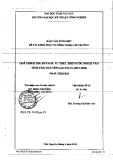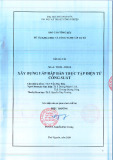
BioMed Central
Page 1 of 13
(page number not for citation purposes)
Journal of Translational Medicine
Open Access
Research
A highly invasive human glioblastoma pre-clinical model for testing
therapeutics
Qian Xie*1, Ryan Thompson1, Kim Hardy2, Lisa DeCamp3, Bree Berghuis4,
Robert Sigler4, Beatrice Knudsen5, Sandra Cottingham6, Ping Zhao7,
Karl Dykema8, Brian Cao7, James Resau4, Rick Hay2 and George F Vande
Woude*1
Address: 1Laboratory of Molecular Oncology, Van Andel Research Institute, 333 Bostwick Avenue NE, Grand Rapids, MI 49503, USA, 2Laboratory
of Noninvasive Imaging and Radiation Biology, Van Andel Research Institute, 333 Bostwick Avenue NE, Grand Rapids, MI 49503, USA,
3Transgenic Core Program, Van Andel Research Institute, 333 Bostwick Avenue NE, Grand Rapids, MI 49503, USA, 4Laboratory of Analytical,
Cellular, and Molecular Microscopy, Van Andel Research Institute, 333 Bostwick Avenue NE, Grand Rapids, MI 49503, USA, 5Program in Cancer
Biology, Fred Hutchinson Cancer Research Center, Division of Public Health Sciences, 1100, Fairview Avenue North, Seattle, WA 98109, USA,
6Department of Neuropathology, Spectrum Health Hospitals, 100 Michigan Street NE, Grand Rapids, MI 49503, USA, 7Laboratory of Antibody
Technology, Van Andel Research Institute, 333 Bostwick Avenue NE, Grand Rapids, MI 49503, USA and 8Laboratory of Bioinformatics, Van Andel
Research Institute, 333 Bostwick Avenue NE, Grand Rapids, MI 49503, USA
Email: Qian Xie* - qian.xie@vai.org; Ryan Thompson - ryan.thompson@vai.org; Kim Hardy - kim.hardy@vai.org;
Lisa DeCamp - lisa.decamp@vai.org; Bree Berghuis - bree.berghuis@vai.org; Robert Sigler - r.sigler@vai.org;
Beatrice Knudsen - bknudsen@fhcrc.org; Sandra Cottingham - sandra.cottingham@spectrum-health.org; Ping Zhao - ping.zhao@vai.org;
Karl Dykema - karl.dykema@vai.org; Brian Cao - brian.cao@vai.org; James Resau - james.resau@vai.org; Rick Hay - hayrick1@attbi.com;
George F Vande Woude* - george.vandewoude@vai.org
* Corresponding authors
Abstract
Animal models greatly facilitate understanding of cancer and importantly, serve pre-clinically for evaluating
potential anti-cancer therapies. We developed an invasive orthotopic human glioblastoma multiforme
(GBM) mouse model that enables real-time tumor ultrasound imaging and pre-clinical evaluation of anti-
neoplastic drugs such as 17-(allylamino)-17-demethoxy geldanamycin (17AAG). Clinically, GBM metastasis
rarely happen, but unexpectedly most human GBM tumor cell lines intrinsically possess metastatic
potential. We used an experimental lung metastasis assay (ELM) to enrich for metastatic cells and three of
four commonly used GBM lines were highly metastatic after repeated ELM selection (M2). These GBM-
M2 lines grew more aggressively orthotopically and all showed dramatic multifold increases in IL6, IL8,
MCP-1 and GM-CSF expression, cytokines and factors that are associated with GBM and poor prognosis.
DBM2 cells, which were derived from the DBTRG-05MG cell line were used to test the efficacy of 17AAG
for treatment of intracranial tumors. The DMB2 orthotopic xenografts form highly invasive tumors with
areas of central necrosis, vascular hyperplasia and intracranial dissemination. In addition, the orthotopic
tumors caused osteolysis and the skull opening correlated to the tumor size, permitting the use of real-
time ultrasound imaging to evaluate antitumor drug activity. We show that 17AAG significantly inhibits
DBM2 tumor growth with significant drug responses in subcutaneous, lung and orthotopic tumor
locations. This model has multiple unique features for investigating the pathobiology of intracranial tumor
growth and for monitoring systemic and intracranial responses to antitumor agents.
Published: 3 December 2008
Journal of Translational Medicine 2008, 6:77 doi:10.1186/1479-5876-6-77
Received: 31 October 2008
Accepted: 3 December 2008
This article is available from: http://www.translational-medicine.com/content/6/1/77
© 2008 Xie et al; licensee BioMed Central Ltd.
This is an Open Access article distributed under the terms of the Creative Commons Attribution License (http://creativecommons.org/licenses/by/2.0),
which permits unrestricted use, distribution, and reproduction in any medium, provided the original work is properly cited.






























